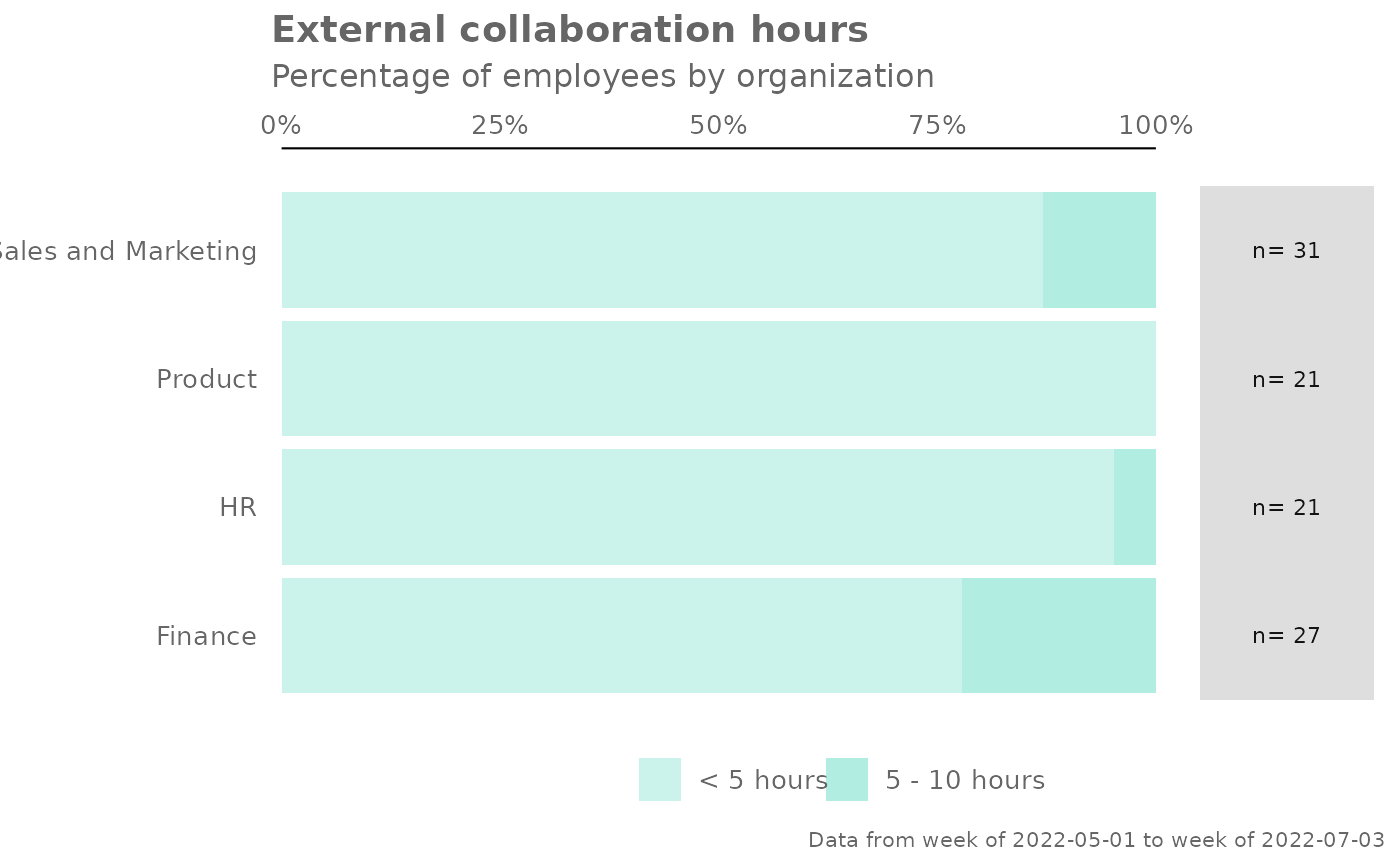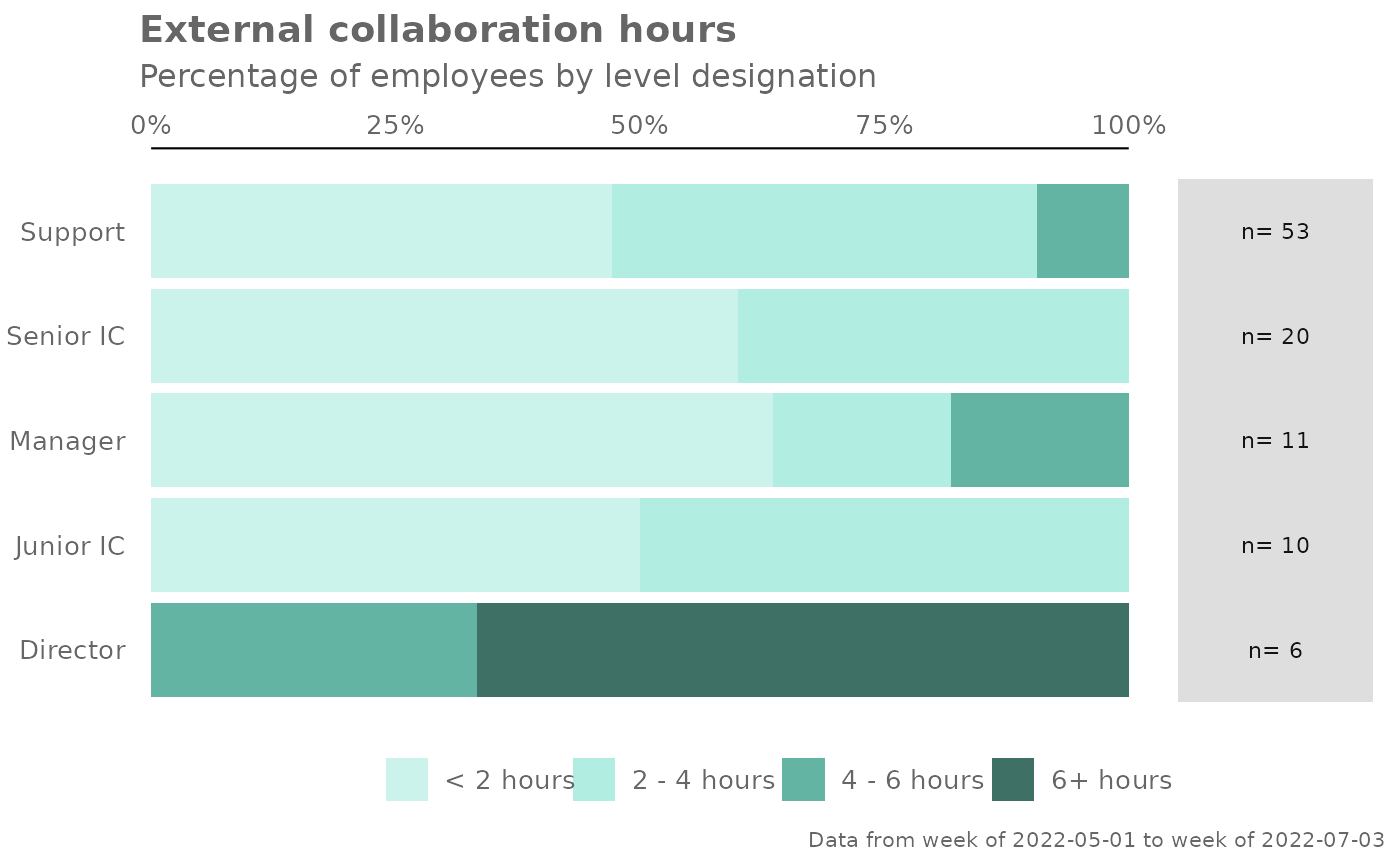
Distribution of External Collaboration Hours as a 100% stacked bar
Source:R/external_dist.R
external_dist.RdAnalyze the distribution of External Collaboration Hours. Returns a stacked bar plot by default. Additional options available to return a table with distribution elements.
Usage
external_dist(
data,
hrvar = "Organization",
mingroup = 5,
return = "plot",
cut = c(5, 10, 15)
)Arguments
- data
A Standard Person Query dataset in the form of a data frame.
- hrvar
String containing the name of the HR Variable by which to split metrics. Defaults to
"Organization". To run the analysis on the total instead of splitting by an HR attribute, supplyNULL(without quotes).- mingroup
Numeric value setting the privacy threshold / minimum group size. Defaults to 5.
- return
String specifying what to return. This must be one of the following strings:
"plot""table"
See
Valuefor more information.- cut
A numeric vector of length three to specify the breaks for the distribution, e.g. c(10, 15, 20)
Value
A different output is returned depending on the value passed to the return argument:
"plot": 'ggplot' object. A stacked bar plot for the metric."table": data frame. A summary table for the metric.
Details
Uses the metric External_collaboration_hours.
See create_dist() for applying the same analysis to a different metric.
See also
Other Visualization:
afterhours_dist(),
afterhours_fizz(),
afterhours_line(),
afterhours_rank(),
afterhours_summary(),
afterhours_trend(),
collaboration_area(),
collaboration_dist(),
collaboration_fizz(),
collaboration_line(),
collaboration_rank(),
collaboration_sum(),
collaboration_trend(),
create_bar(),
create_bar_asis(),
create_boxplot(),
create_bubble(),
create_dist(),
create_fizz(),
create_inc(),
create_line(),
create_line_asis(),
create_period_scatter(),
create_rank(),
create_rogers(),
create_sankey(),
create_scatter(),
create_stacked(),
create_tracking(),
create_trend(),
email_dist(),
email_fizz(),
email_line(),
email_rank(),
email_summary(),
email_trend(),
external_fizz(),
external_line(),
external_rank(),
external_sum(),
hr_trend(),
hrvar_count(),
hrvar_trend(),
keymetrics_scan(),
meeting_dist(),
meeting_fizz(),
meeting_line(),
meeting_rank(),
meeting_summary(),
meeting_trend(),
one2one_dist(),
one2one_fizz(),
one2one_freq(),
one2one_line(),
one2one_rank(),
one2one_sum(),
one2one_trend()
Other External Collaboration:
external_fizz(),
external_line(),
external_sum()
Examples
# Return plot
external_dist(pq_data, hrvar = "Organization")
 # Return summary table
external_dist(pq_data, hrvar = "Organization", return = "table")
#> # A tibble: 7 × 4
#> group `5 - 10 hours` `10 - 15 hours` Employee_Count
#> <fct> <dbl> <dbl> <int>
#> 1 Finance 0.868 0.132 68
#> 2 HR 1 NA 33
#> 3 IT 0.912 0.0882 68
#> 4 Legal 0.977 0.0227 44
#> 5 Operations 0.727 0.273 22
#> 6 Research 0.808 0.192 52
#> 7 Sales 0.923 0.0769 13
# Return result with a custom specified breaks
external_dist(pq_data, hrvar = "LevelDesignation", cut = c(2, 4, 6))
# Return summary table
external_dist(pq_data, hrvar = "Organization", return = "table")
#> # A tibble: 7 × 4
#> group `5 - 10 hours` `10 - 15 hours` Employee_Count
#> <fct> <dbl> <dbl> <int>
#> 1 Finance 0.868 0.132 68
#> 2 HR 1 NA 33
#> 3 IT 0.912 0.0882 68
#> 4 Legal 0.977 0.0227 44
#> 5 Operations 0.727 0.273 22
#> 6 Research 0.808 0.192 52
#> 7 Sales 0.923 0.0769 13
# Return result with a custom specified breaks
external_dist(pq_data, hrvar = "LevelDesignation", cut = c(2, 4, 6))
